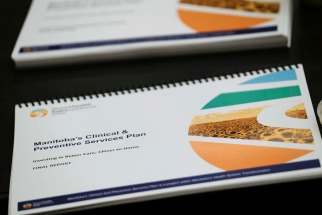Health-care plan’s goal is to improve services outside Winnipeg, reduce strain in city
Read this article for free:
or
Already have an account? Log in here »
To continue reading, please subscribe:
Monthly Digital Subscription
$0 for the first 4 weeks*
- Enjoy unlimited reading on winnipegfreepress.com
- Read the E-Edition, our digital replica newspaper
- Access News Break, our award-winning app
- Play interactive puzzles
*No charge for 4 weeks then price increases to the regular rate of $19.00 plus GST every four weeks. Offer available to new and qualified returning subscribers only. Cancel any time.
Monthly Digital Subscription
$4.75/week*
- Enjoy unlimited reading on winnipegfreepress.com
- Read the E-Edition, our digital replica newspaper
- Access News Break, our award-winning app
- Play interactive puzzles
*Billed as $19 plus GST every four weeks. Cancel any time.
To continue reading, please subscribe:
Add Free Press access to your Brandon Sun subscription for only an additional
$1 for the first 4 weeks*
*Your next subscription payment will increase by $1.00 and you will be charged $16.99 plus GST for four weeks. After four weeks, your payment will increase to $23.99 plus GST every four weeks.
Read unlimited articles for free today:
or
Already have an account? Log in here »
Hey there, time traveller!
This article was published 29/11/2019 (2207 days ago), so information in it may no longer be current.
Manitoba is embarking on what is being characterized as the first fully integrated provincial health services delivery program in its history.
Health officials said Friday the goal is to bring health services closer to those who need it, reducing trips by rural and northern residents to Winnipeg for care.
Boosting health services outside the Perimeter Highway will free up hospital capacity in the city, where facilities are straining to meet patient demand, they said.

The Manitoba Clinical and Preventive Services Plan, released Friday, was developed over the past 18 months by nearly 300 clinical leaders with the input of more than 3,000 front-line service providers, government and health officials told a media briefing.
“It is a plan ‘by’ Manitobans ‘for’ Manitobans,” Health Minister Cameron Friesen said, adding the government will allocate $250 million in new funding over the next four years for implementation.
Many of the operational details are yet to be worked out.
However, the goal is to increase access to primary and community care across Manitoba, including improved access to diagnostic services, emergency response and patient transportation.
Greater use of technology will be used, where possible, to reduce the need for repeat visits to doctors and specialists.
“It is a shift from a focus on Winnipeg to a focus on getting that care in rural and northern Manitoba.”–Health Minister Cameron Friesen
Brandon and other larger centres outside of Winnipeg will become more important regional health-care hubs, capable of providing more specialized surgeries and other services that are now done only in Winnipeg.
“It is a shift from a focus on Winnipeg to a focus on getting that care in rural and northern Manitoba,” Friesen said.
He said there will also be more emphasis on community care rather than hospital care throughout the province.
Key observations from the report
• About 75 per cent of all Manitoba in-patient and day surgeries occur in Winnipeg, and more than half of all rural and northern patients travel outside their region to access these procedures. At the same time, operating rooms across the province are not operating to full capacity, with some shutting down at noon.
• About 75 per cent of all Manitoba in-patient and day surgeries occur in Winnipeg, and more than half of all rural and northern patients travel outside their region to access these procedures. At the same time, operating rooms across the province are not operating to full capacity, with some shutting down at noon.
• Currently, about 80 per cent of critical care services are provided in Winnipeg. Paramedics transporting critical care patients often bypass Brandon on the way to Winnipeg. The report recommends improving Brandon’s capability in the areas of critical care and acute medicine.
• More than half of Manitobans aged 40 and over have more than one chronic health condition (including hypertension). Of this group, 20 per cent have more than two chronic conditions.
• The population’s health status varies across the province, as do access to services and clinical practice standards. For example, the prevalence of diabetes in the northern region is double the provincial rate. And Prairie Mountain Health has a higher prevalence of C-section births (30% compared to the provincial rate of 23%).
• Wait lists for in-home IV therapy to treat infections following surgery are reported to be seven to 14 days. Health officials are looking to train more home care nurses to provide services such as as in-home and community IV therapy.
According to the plan, contained in 350 pages of documents released Friday, the government hopes to free up an estimated 90,000 extra patient-bed days in hospitals annually within five years.
Also within five years, some “21,000 days of care” annually will be shifted out of Winnipeg to rural and northern communities.
Once the plan is in effect, it’s expected that 2,500 fewer patient transports to Winnipeg will be required annually as rural facilities become better-equipped to provide care.
There are also plans to provide an additional 50,000 home-care visits while modernizing the system to provide more specialized services. As well, 800 Manitobans will receive access to remote monitoring of their chronic conditions, allowing them to remain in their communities.
Further investments are also planned in electronic records-keeping to extend access to 800,000 patients in Manitoba.
Not enough prevention, no new investments: opposition
Manitoba’s opposition leaders expressed several concerns about the government’s blueprint, including what they saw as a lack of focus on preventive measures.
“What about preventing heart disease? What about preventing cancer? What about preventing diabetes? Those are the health outcomes that we should be concerned about here in the province of Manitoba,” NDP Leader Wab Kinew said.

Kinew said he’s also worried about possible hospital ER closures in rural Manitoba. “The government should be honest and tell us what emergency departments they plan to close as part of this plan,” he said.
Liberal Leader Dougald Lamont had much the same focus, saying the government’s plan fails to emphasize prevention, particularly as it relates to diabetes.
“There’s too much focus on technology. There’s too much focus on shifting around existing resources and not enough about new investments and on prevention,” he said.
Few front-line workers consulted: unions
Two unions that represent health-care workers said as far as they were aware, few front-line workers were involved in the creation of the plan.

Bob Moroz, president of the Manitoba Association of Health Care Professionals, said he combed through the list of 300 clinical leaders who produced the documents and found “a lot of management (and) a lot of administrators,” particularly from rural areas.
“It was very difficult to find any front-line folks who look after us every day,” he said. “To me, it appears to be very much a consultation with management.”
Darlene Jackson, president of the Manitoba Nurses Union, said the plan was developed without meaningful consultation with the MNU and front-line nurses.
She said she hopes that health-care officials learn from the mistakes made in the consolidation of Winnipeg hospital services, which has left the three remaining hospital ERs swamped with work.
“You have to have your services in place. You have to have your capacity. You have to have staff ready before you transition to the new model,” Jackson said.
larry.kusch@freepress.mb.ca
Overview of Manitoba’s Clinical and Preventive Services Plan

Our newsroom depends on a growing audience of readers to power our journalism. If you are not a paid reader, please consider becoming a subscriber.
Our newsroom depends on its audience of readers to power our journalism. Thank you for your support.
History
Updated on Friday, November 29, 2019 5:52 PM CST: Full story added.
Updated on Friday, November 29, 2019 6:22 PM CST: Updates layout.
Updated on Friday, November 29, 2019 8:51 PM CST: Fixes typo










